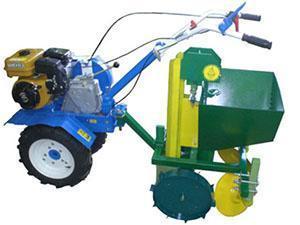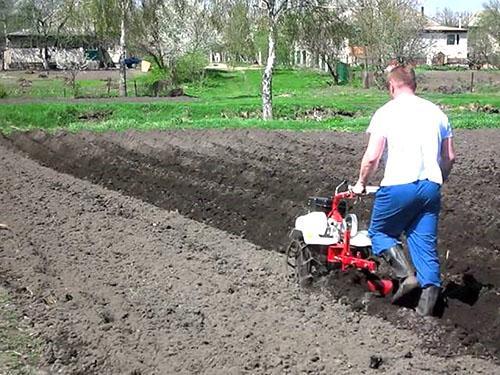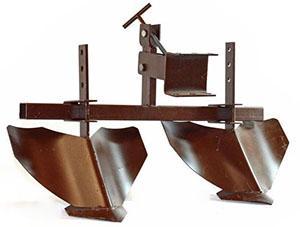Planting potatoes with a walk-behind tractor with a hiller
 A universal device - a walk-behind tractor, helps the gardener to perform many tasks on the garden plot much faster and more efficiently. Gardening tasks include plowing, hilling, planting, weeding and harvesting potatoes with a walk-behind tractor, a multifunctional and irreplaceable machine on the farm.
A universal device - a walk-behind tractor, helps the gardener to perform many tasks on the garden plot much faster and more efficiently. Gardening tasks include plowing, hilling, planting, weeding and harvesting potatoes with a walk-behind tractor, a multifunctional and irreplaceable machine on the farm.
How to plant potatoes with a walk-behind tractor

- with the help of a hiller with regulation of the gap between the wings;
- using a mounted potato planter.
Method number 1.
 Potatoes are planted with a walk-behind tractor with a hiller as follows: lug wheels are mounted on the unit and hiller... Then the grooves are cut. The smoother they are, the easier it is to take care of the potatoes in the future. A root crop is manually placed in these recesses. After the completion of the stage, the lug wheels are changed to rubber wheels, which will correspond to the track width. Thanks to rubber wheels, the device does not damage the potatoes, but covers it with earth and tamp it. Thus, the planting of the root crop is carried out.
Potatoes are planted with a walk-behind tractor with a hiller as follows: lug wheels are mounted on the unit and hiller... Then the grooves are cut. The smoother they are, the easier it is to take care of the potatoes in the future. A root crop is manually placed in these recesses. After the completion of the stage, the lug wheels are changed to rubber wheels, which will correspond to the track width. Thanks to rubber wheels, the device does not damage the potatoes, but covers it with earth and tamp it. Thus, the planting of the root crop is carried out.
Read also:potato pancakes with minced meat - a recipe with a photo step by step in a pan.
Method number 2.
 When huge areas are allocated for potatoes, it is advisable to plant with a walk-behind tractor with a canopy. The first step is to prepare the soil:
When huge areas are allocated for potatoes, it is advisable to plant with a walk-behind tractor with a canopy. The first step is to prepare the soil:
- plowing the garden;
- harrowing so that the seedlings can receive the necessary moisture and oxygen;
- moistening the soil (if possible).
Next, the ridges are pre-cut. The potato planter has furrows, a device for feeding tubers into the prepared pits and a disc hiller for backfilling potatoes. Thanks to this "versatility", several operations can be carried out simultaneously - cut furrows, lay tubers and fill them. At the beginning of work, lug wheels are put on the unit, and a potato planter is put on the walk-behind tractor. Parameters are adjusted for further work.
To obtain a high ridge, the disks of the device approach each other, and the deepening of the furrow increases. And to reduce - the reverse procedure is performed, the disks move apart, while reducing the angle of attack.
Potatoes are placed in a special compartment, and while the walk-behind tractor is moving, it is fed into the prepared furrows. The frequency can be controlled manually, or you can completely trust the technique. After planting, the furrows are closed and the soil is compacted. You can pour on top organic fertilizer, and moisten the soil.
Processing the garden with a walk-behind tractor
 Correct processing of the garden with a walk-behind tractor is carried out using special attachments or hook-on devices. After this action, the soil is enriched with oxygen, all weeds are removed, and the tubers grow freely and faster. This task is for every summer resident and is performed without much difficulty. The main thing is to adjust the attachments before plowing, adjust the plow grip (by rotating the handle on the universal hitch). If everything is done correctly, then holding and guiding the walk-behind tractor along the furrows will be easy.
Correct processing of the garden with a walk-behind tractor is carried out using special attachments or hook-on devices. After this action, the soil is enriched with oxygen, all weeds are removed, and the tubers grow freely and faster. This task is for every summer resident and is performed without much difficulty. The main thing is to adjust the attachments before plowing, adjust the plow grip (by rotating the handle on the universal hitch). If everything is done correctly, then holding and guiding the walk-behind tractor along the furrows will be easy.
The plowing depth should be within 19-20cm, after such a procedure the need for harrowing the soil disappears!
The attachment for the walk-behind tractor has a special plow that makes uniform furrows at a certain depth.After that, manually or with the help of a potato planter, the potatoes are laid out in the furrows and the tubers are covered with soil with the hillers.
Processing potatoes after sprouting
 After 2-3 weeks, when all the seedlings have already appeared, the next process begins, which can also be performed using a walk-behind tractor. The entire planting area is divided into furrows, the soil is loosened up and paths are formed for convenient movement between rows. Hilling has a beneficial effect on the germination of stems, removes weeds, retains moisture in the soil, and forms an excellent protection of young plants from the first frost.
After 2-3 weeks, when all the seedlings have already appeared, the next process begins, which can also be performed using a walk-behind tractor. The entire planting area is divided into furrows, the soil is loosened up and paths are formed for convenient movement between rows. Hilling has a beneficial effect on the germination of stems, removes weeds, retains moisture in the soil, and forms an excellent protection of young plants from the first frost.
This process is provided by a special nozzle on the walk-behind tractor - one, two- or three-row hiller. During hilling, fertilizer should be applied to the soil with an additional nozzle, which is installed on the potato planter.
Inter-row processing
 During the flowering period, potatoes need special loosening of the soil between the rows, which will allow the root crop to grow faster, guaranteeing a good harvest. The first time the potatoes are weeded with a walk-behind tractor on the eighth day after planting, at this time a dense crust appears on the ground, which complicates the growth of the stems.
During the flowering period, potatoes need special loosening of the soil between the rows, which will allow the root crop to grow faster, guaranteeing a good harvest. The first time the potatoes are weeded with a walk-behind tractor on the eighth day after planting, at this time a dense crust appears on the ground, which complicates the growth of the stems.
And then - every 7 days, until the aisles become inaccessible. Weeding can be done either manually or mechanically. The main thing is to remove the weeds on time, so that they do not complicate the growth of seedlings and do not negatively affect the development of the root crop.
Weeding with a harrow
 Such a device is put on a walk-behind tractor. Mesh cells have a side of about 20 cm, located at a 45 degree angle. The harrow is effective due to the fact that it immediately covers a large area, but it will not be possible to process the row spacing with it “cleanly”. The best way to eliminate weeds is to pull them out by the roots. Then the potatoes will be cleaner, and less weeding will have to be done. Well, that's all, the main tasks of the gardener have been completed. It remains to wait for the right time and you can harvest! And in this case, the walk-behind tractor will be an excellent assistant!
Such a device is put on a walk-behind tractor. Mesh cells have a side of about 20 cm, located at a 45 degree angle. The harrow is effective due to the fact that it immediately covers a large area, but it will not be possible to process the row spacing with it “cleanly”. The best way to eliminate weeds is to pull them out by the roots. Then the potatoes will be cleaner, and less weeding will have to be done. Well, that's all, the main tasks of the gardener have been completed. It remains to wait for the right time and you can harvest! And in this case, the walk-behind tractor will be an excellent assistant!
Homemade potato digger for walk-behind tractor
 To harvest potatoes, craftsmen make a special device - a potato digger for a walk-behind tractor. The equipment consists of a welded frame, a ploughshare, an editorial unit, a cleaner drum. To collect the device, you will need some skills and the study of detailed drawings, in a large number presented on the Internet. The result is a quick harvest of potatoes without damaging the tubers and without special labor costs.
To harvest potatoes, craftsmen make a special device - a potato digger for a walk-behind tractor. The equipment consists of a welded frame, a ploughshare, an editorial unit, a cleaner drum. To collect the device, you will need some skills and the study of detailed drawings, in a large number presented on the Internet. The result is a quick harvest of potatoes without damaging the tubers and without special labor costs.
For better assimilation of information, we offer a video hilling potatoes with a Neva walk-behind tractor.
How fast time flies! The villagers also remember how they transferred classes in village schools from September to October. And all because of the potatoes, which were harvested by the whole world. Now the fields of farms cannot be cultivated without equipment. Motoblock "Neva" with mounted implements and works in small areas. But not everyone has yet learned how to combine operations, as shown in the video. In the spring of this year, we had to plant potatoes on a half-hectare plot. The owner cut the furrows, but three of us threw the potatoes behind the walk-behind tractor, and even covered the rows with a rake. I will definitely give my relative a link to this video, let him make such devices by next spring. Thanks for the science
In 2016, I planted on virgin soil - in furrows - 3 varieties: "Gala", "Arosa" and "Yanka" (Middle Volga region. Ulyanovsk).
"Yanka" - late (8 kg), "Arosa" - early (8 kg), "Gala" - medium (10 kg). Only 26 kg.
I planted just over 250 bushes.
In principle, planting in furrows makes the first step easier. Don't dig; I laid out the plot, laid out the tubers and sprinkled it with earth from the edge of the grooves. Although you still have to huddle later.
I noticed one peculiarity for myself: when planting, I sprinkled two varieties with earth (in fact, I immediately spud them) - they sprout for a long time, and apparently there was not enough light at the germination stage - the harvest was modest; and one variety (Gala), for which there was not enough strength to warm the ridges over the planted potatoes (I just sprinkled it with a thin layer), hatched faster than the other two, then huddled together with other varieties, and the yield was almost twice as high. Well, maybe the variety is just so powerful. This year I will not suffer - I will just burrow it into the furrows after planting and then I will pick it up by hilling.
It was easy to dig, the ground was soft and shallow. But one, honestly, did not master it. Did not have enough time. I went to the site after work and on weekends for a couple of hours (on average, it worked once a week).
I planted it myself for the first time, did not apply fertilizer. Lots of insects. BUT! there was not a single Colorado potato beetle (apparently no one was planting potatoes nearby, the plots were abandoned, there were no beetles). But the potatoes lay in the ground. The early variety dried up, the late ones ate insects. There were almost no large potatoes.
Collected buckets 15. Four times more than planted. But for the first time it is normal)) I learned the necessary lessons for myself from this season. I plan to either plant peas together with potatoes, or apply fertilizers. The virgin land turned out to be very poor in vitamins.
It is immediately clear that everything that is written here is the work of a person who did not hold a walk-behind tractor in his hands. All something "without much effort." (“We took the log merrily!”) Try to drag the eared double hiller along the furrow - and you won't understand - the walk-behind tractor is dragging it, or you are pushing the walk-behind tractor. Try to turn the walk-behind tractor with a filled potato planter or the same 40 kg potato digger. weight! It's time to lie in the furrow and die. And when 104 kg. The walk-behind tractor is buried in the ground with cutters and you have to call a neighbor for help to pull it out!
"During hilling, fertilizer should be applied to the soil with an additional nozzle, which is installed on the potato planter" - at least you yourself understood what you wrote ?! Where, excuse me, to shove a potato planter when there are rows of "spike" potatoes around? And who spills potatoes every 7 days? Now you don't need to be a skilled worker to make potato diggers, everything is for sale.
Vladimir V., "motoblock cleaner" with 20 years of experience.